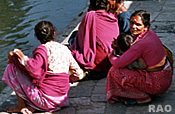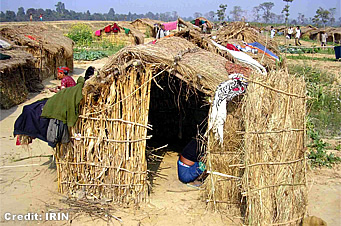 |
Nepal SOCIAL LIFE |
|
 |
Nepal Information |
|
|
 |
|
Former
bonded labourers appeal for help from the government |
 |
KATHMANDU,
3 Jan 2007 (IRIN)
 |
| Many Kamaiya families live in absolute poverty in camps such as this one
in the village of Kalika, near the Bardiya highway about 570 km far west
of Kathmandu
Hundreds
of former bonded labourers, who were freed from slavery nearly six years
ago in western Nepal, are appealing to the government for their proper
rehabilitation, reintegration, and financial support.
Known
as 'Kamaiyas', 500 of the former labourers have been staging their protest
in the capital Kathmandu over the past week, and are now planning to seize
government lands regardless of the consequences, they claim. |
|
"We
will now have to resort to the hard way as that is the only option left
for us now," said 28-year-old Sukhdaya Chaudhary, a member of the Freed
Kamaiya Society, which has been bringing hundreds of Kamaiyas to the capital
from the countryside to help them fight for their rights.
The
former Kamaiyas belong to the Nepalese ethnic group, the Tharus, who were
in bonded labour for more than 40 years.
 |
| Before
the government banned slavery in 2000, more than 100,000 Tharus, including
women and children, were working as bonded labourers, according to the
NGO, the Backward Society Education (BASE) responsible for spearheading
the movement against slavery.
But
despite the ban, there have been few improvements in living conditions,
and the majority of former slaves continue to live below the poverty line
with no source of income, according to the group. |
|
"Most
of our families are still landless and are sleeping in makeshift huts without
any roof. Our children suffer the most," said Pasupati Chaudhary, president
of the Freed Kamaiya Society.
There
are around 32,000 freed Kamaiya families in the five districts of Banke,
Bardiya, Kailali, Kanchanpur and Dang (more than 500 km west of Kathmandu)
in southern Nepal. So far only 12,000 of the families have received land,
while the remaining 20,000 have been deprived of any support from the government,
said Chaudhary.
During
the early 1960s the Tharus were evicted from their lands by the high-caste
migrants from the hill areas who wanted to settle in the rich fertile lands
of southern Nepal.
The
new settlers used violence and tricked the illiterate Tharu community into
signing false loan documents, using their lands as collateral. In the process,
most of the Tharus lost the land they had farmed for generations.
In
order to buy seeds, food and other goods, the Tharus began taking loans
from their new landlords. They were then obliged to work on the agricultural
land they used to own until they had repaid their debts. Most never managed
to pay off their loans as the interest rates were constantly rising. The
Tharus were therefore kept in perpetual servitude, working upwards of 18
hours a day.
Source: IRIN 2007
Copyright
© UN Office for the Coordination of Humanitarian Affairs 2007
[
This report does not necessarily reflect the views of the United Nations]
Integrated
Regional Information Networks (IRIN), part of the UN Office for the Coordination
of Humanitarian Affairs (OCHA). |
 |
 |
 |
Externe
Links |
|




